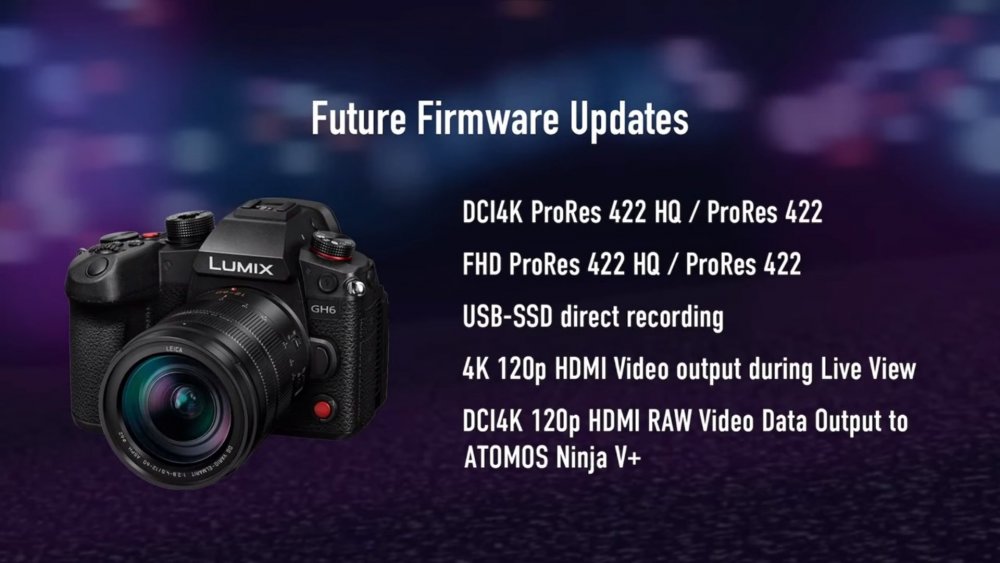-
Posts
2,539 -
Joined
-
Last visited
Content Type
Profiles
Forums
Articles
Everything posted by sanveer
-
Interesting, most of the size increase seems to have been due to the new articulating screen and the sturucyursly sturdiness of the frame.
-
I don't know if this has been posted before, but this review is very important from a user's perspective (IMHO). Also, he tests a lot of things, especially in comparison to many previous M43 cameras, and also the A1 (for autofocus).
-
So it isn't a Sony sensor for a change(?). It wouldn't be TowerJazz Semiconductor/ Tower Semi, I am guessing, either. Like someone on some rumours blog suggested (photorumors/ 43rumors?), it's probably an ONSemi sensor. Maybe by not having 14-bit ADC and impressing it for a 16-bit image (having it limited to 12-bit, both ways, meaning recording and delivery), they could substantially reduce sensor costs, and not have a conflict of interest with Arri. Arri has like a few hundred sensors manufactured each year, and Panasonic hopes go have a few thousands, thus leveraging economies of scale and tech specs to (substantially) lower costs. Sony does dual gain, but that's quite different. Also, I am not sure Canon supplies sensor to Panasonic (they could if they don't see issues with specific markets). I also vaguely remember Panasonic saying it's similar to Arri or something on those lines. Interestingly, while some testers are mentioning banding lines when pointed towards lights, I though that that's something that's visible for the majority of CMOS sensor. Maybe even super fast sensors like the Z9 or A1 would have it under certain scenarios (the A9 did, I clearly remember). People seem to notice it now, because one guy mentioned it and everyone is pointing it towards flickering LED light sources now. Maybe having different rates of lights and sensor readout acerbates the problem (use the Synchro Scan feature to figure the right frame rate and shutter speed for you?).
-
Yes. Caleb mentioned that the new colour science is vastly improved.
-
-
Selective bias. Also, I hope Panasonic release a chart like Blackmagic does for the Shadows and Highlights for the 4k and 6k cameras, helping understand where almost perfect exposure would lay (is allocated) apart from the histogram, across ISOs (especially for extended ISO).
-
Waiting for Andrew's review. I believe he got to test the GH6 (for quite a while?).
-
As shared by @webrunner5, watch this guy instead
-
I thought his review was so exaggerated. He was like "when ypu want the best impossible image, M43 is dead". Whoa, it almost seemed like he was dumped today or yesterday.
-
I noticed that from the pics online too. The OM-1 seems quite promising, though it could have done with a CfastCF Express Type cards (much higher buffer?), higher video bitrates, 4k at 120fps, a faster mechanical shutter, and a $1999 price tag to capture a larger market(?)
-
"Latitude Dynamic Range Boost ON: 13+ stops (V-Log) Dynamic Range Boost OFF: 12+ stops (V-Log)Still Image Recording file formatJPEG (DCF, Exif 2.31), RAWAspect ratio4:3 / 3:2 / 16:9 / 1:1File size (Pixels)4:3: 5776x4336(L) / 4096x3072(M) / 2944x2208(S) / 11552x8672(XL) / 8192x6144(LL)3:2: 5776x3848(L) / 4096x2728(M) / 2944x1960(S) / 11552x7696(XL) / 8192x5464(LL)16:9: 5776x3248(L) / 4096x2304(M) / 2944x1656(S) / 11552x6496(XL) / 8192x4608(LL)1:1: 4336x4336(L) / 3072x3072(M) / 2208x2208(S) / 8672x8672(XL) / 6144x6144(LL)Image qualityRAW / RAW+Fine / RAW+Standard / Fine / StandardColor spacesRGB, AdobeRGBMotion Picture Recording file formatMOV: H.264/MPEG-4 AVC, H.265/HEVC, Apple ProResMP4: H.264/MPEG-4 AVC, H.265/HEVCAudio formatMOV: LPCM (2ch 48kHz/24-bit, 96kHz/24-bit) (4ch 48kHz/24-bit, 96kHz/24-bit)MP4: AAC (2ch 48kHz/16-bit)System frequency59.94Hz / 50.00Hz / 24.00HzImage area of videoFull / Pixel by PixelViewfinder TypeOLED Live View FinderPixelsApprox. 3.68 million dots Dynamic Range Boost ON / OFF ISO sensitivityStill image:[Normal]: Auto / 50 (Extended ISO) / 100-25600[V-Log]: Auto / 125 (Extended ISO) / 250-12800Motion picture:[Normal]:Dynamic Range Boost OFF (Base ISO 100): Auto / 50 (Extended ISO) / 100-12800Dynamic Range Boost ON (Creative Video Mode) (Base ISO 800): Auto / 800-12800[V-Log]:Dynamic Range Boost OFF (Base ISO 250): Auto / 125 (Extended ISO) / 250-12800Dynamic Range Boost ON (Creative Video Mode) (Base ISO 2000): Auto / 2000-12800[Hybrid Log Gamma]:Dynamic Range Boost OFF (Base ISO 250): Auto / 250-12800Dynamic Range Boost ON (Creative Video Mode) (Base ISO 2000): Auto / 2000-12800 (Standardoutput sensitivity)" Curious to know how effective the dynamic range boost would be.
-
I saw the video again. Data rate doesn't seem to be mentioned in English numbers (unless it was in Japanese). At 6:39 or so he shows the ProRes recording option on the menu.
-
The accompanying video by the japanese guy outlined a lot of the specs. I don't remember whether it had a frame of the ProRes though.
-
I didn't realise the full specs were already shared. Seems quite promising. I am curious about the autofocus, the dynamic range and low light improvements.
-
Your be glad to know that 14 stops is the theoretical limitation of a senior's dynamic range, because of the lens flare. So everyone claiming 17 stops, are just gassing. Without exceptional lens coatings on on all lenses of the various lens elements, it is apparently impossible to breach the 14 stops limit. "Camera DR is often limited by flare light, which is stray light in the image, primarily caused by reflections between lens elements." https://www.imatest.com/2019/07/making-dynamic-range-measurements-robust-against-flare-light/#:~:text=Introduction,by reflections between lens elements. That organic sensor was apparently a gas-guzzler/ battery leech, and the advantage of the organic sensor was mostly imaginary BS ala the Emperor's New Clothes. If anything the Blackmagic 12k is superb for what it does. It does 12k and 8k, and many other resolutions, many with no crop. If Panasonic did their homework well, they could have picked that sensor and tweak the circuit for improving things, for 8k. They were too busy chasing their imaginary organic sensor (Samsung btw has some interesting paper on an organic sensor, which seemed more promising, though not sure what happened to it).
-
Didn't they suspend their Twitter account. Some over-reaction by corporations, who weren't too happy with leaks(?)
-
On M43 rumours there are murmurs of the OM having the 20MP 120fps sensor with 2 stops improvement in low light, and the GH6 apparently slated for a 25MP sensor (for the 5.7k).
-
Because it Theoretically Doubles the Pixel Size via a viz signal strength (actually doubles the pixel area).
-
🤣 Unlikely. Not likely either. Which is sad, cause Samsung and Sony both presented papers on Triple Gain sensors (for smaller sensors, I guess), and if Panasonic wanted they could have made the most of the tech, for a M43 sensors. I thought it was established that the resolution advantage is mostly blurred after a certain point, and better noise, lenses etc mostly blur the lines. Steve Yedlin's and hundreds of other presentation on resolution go into the exaggerated claims and why after a point why it doesn't matter. Arri's discussion on it seems quite interesting. https://www.newsshooter.com/2015/08/14/arri-managing-director-franz-kraus-talks-about-resolution-hdr-and-the-arri-65/ Mist interesting of all, Sony presented its stacked CMOS image sensor technology with 2-Layer Transistor Pixel, widening Dynamic Range and Reduces Noise by approximately Doubling Saturation Signal Level (since surface area isn't being wasted, because the photo diode pixel transistor are in the same level (so only 50% area is used for the photo diode). Theoretically this should sensor at the same pixel seem much better in detail and dynamic range. The question would be, by how much. https://www.sony-semicon.co.jp/e/news/2021/2021121601.html More than anything else I am curious why nobody feels the Blackmagic 12k Camera No Crop Resolutions is a big deal. Especially for its price point, shooting 12k at 60p 8k and 4k at 120fps, Without Cropping or Changing Your Field of View. Wonder why nobody seems to have gone that path.
-
The GH6 is such a minor upgrade in most ways, that, it's 'a GH5 with the weaknesses remedied'. That's good enough, even if solely improves dynamic range and Autofocus.
-
I sometimes feel that the GH5 was was 90% already there, and only a few minor improvement would keep it relevant for another half decade. 5.7k should have been complete 6k, at 60p. 4k at 120fps. Dynamic Range improvements. Usable video ISO 6400 PDAF comparable to that on Sony and Canon cameras Having much better AR coating across all lenses and on the sensor, should help improve dynamic range. Full Vlog Make it a Netflix Certified Camera 😎 One last, extra, would be to work with Topaz Labs to have upressing to 8k video and Photos at 40-60MP, purely by software upressing. This should make to compare to the 8k Cameras and the 50+MP Cameras.
-
Actually many manufacturers have been wanting to get out of China since the beginning of 2020. The Pandemic and the whole expansionism contributed big time to it. The Japanese Government even paid businesses billions of yen to move out of China (https://www.bloombergquint.com/global-economics/japan-to-pay-at-least-536-million-for-companies-to-leave-china). I believe many other countries with manufacturing in China did too, and many large ones left are contemplating too. The environment for manufacturing has been losing its advantage for a while now, and the whole friction with its Asian neighbours, was probably the last nail.in the coffin (surprisingly, not Covid or the terrible lockdown so much). Apple seems to be one of the few ones, that has been able to retain much (not all) of its advantage. It pays higher wages than before, but their other sweat shop practices, apparently haven't gone. They paid enormous sums apparently including the majority as political money, to continue running their sweat shops. https://9to5mac.com/2021/12/07/apple-china-iphone-pledge/
-
Seems quite average. The image seemed way too flary, and the movement is dull.
-
What device did you get to test it on? I hope they list the devices it works best on (stability, more frame rate options etc). Btw, I read a rumour that the new Samsung 22 Ultra is going to shoot RAW. If it shoots raw video, that would be superb. It already does 10-bit upressed to 12-bit HDR for photos, so I hope its 12-bit RAW video. Not sure why smartphone makers are already supporting RAW. If their cameras can do 10-bit 4-2-0 already, and 8k (8-bit?), I am sure they have the bandwidth and the processing power. Any even get that rubbish Camera2API on devices, with its limiting features.
-
Wow, the image looks great. I wanna try it. Am just a little hesitant, like with trying out the various hacks on the GH2. I'm sure thus is going to be great. I have a spare smartphone. Maybe I use it.on that one.





